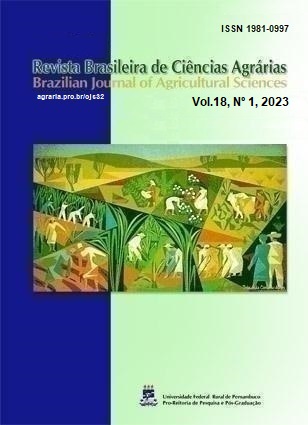Produtividade de feijão-caupi, milho e soja utilizando formulações granuladas à base de farinha de ossos na Amazônia Oriental
DOI:
https://doi.org/10.5039/agraria.v18i1a2577Palavras-chave:
resíduos agroindustriais, fertilizante organomineral, adubação fosfatadaResumo
O objetivo deste trabalho foi avaliar a eficiência de formulações granuladas, produzidas com farinha de osso calcinada como fonte de fósforo, em feijão-caupi, soja e milho. Em casa de vegetação, os tratamentos consistiram em dois solos com diferentes teores de argila (231 e 376 g kg-1), três formulações NPK (08-20-10, 02-20-10 e 01-20-00 preparadas com farinha de osso bovino, fosfato monoamônico, sulfato de amônio, ureia e cloreto de potássio e fosforita) e três sucessões de culturas (feijão-caupi/milho/soja, soja/feijão-caupi/milho e milho/soja/feijão-caupi). No campo, os tratamentos consistiram em quatro níveis de NPK 08-20-10 para milho, e NPK 02-20-10 para soja, em cerrado, e de NPK 02-20-10 para feijão-caupi, em ambiente de cerrado e floresta de terra firme. A adubação com as formulações NPK promove maior massa seca da parte aérea da soja, feijão-caupi e milho no solo franco-argiloarenoso do que em solo argiloarenoso e maior produtividade de grãos de feijão-caupi em ambiente de cerrado do que em floresta de terra firme. A produtividade de grãos do feijão-caupi BRS Tumucumaque e do milho BRS 206 responde linearmente ao aumento da adubação com as formulações. O aumento da dose de adubação não afeta a produtividade de grãos da soja BRS Tracajá em ambiente de cerrado.
Downloads
Downloads
Publicado
Como Citar
Edição
Seção
Licença

Este trabalho está licenciado sob uma licença Creative Commons Attribution 4.0 International License.


